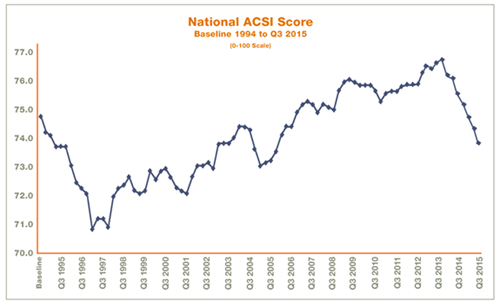Date Published February 2, 2016 - Last Updated October 5, 2016
Companies are spending billions of dollars annually in an effort to improve the customer experience. Unfortunately, satisfaction is not improving.

Making improvements in the customer experience is proving to be a very vexing business challenge. As you can see from the data, our efforts to impact customer experience successfully delivered increases in customer satisfaction scores steadily for many years. We had it all figured out, and we thought that if we just kept on that same path, it would continue to work. However, despite our best efforts, we just aren’t making the impact that we once did. Why is this?
To get to the root cause, let's imagine together a time when we had a great customer experience when dining out. Here we see many of the critical key moments of truth:
- Exterior signage compels you and accurately articulates the experience you can expect.
- Details within the interior have been carefully crafted to make you feel at ease
- You are greeted warmly yet professionally by a well-trained staff member who puts you at ease and sets expectations.
- After making your way to the table, you are presented with a thoughtfully prepared menu.
- Well-trained wait staff greet you promptly and professionally and provide all information you need to feel comfortable.
- Your meal exceeds your expectations in creativity and quality.
- As you leave, you feel that your money was well spent and the restaurant delivered on its promises to you.
While this is a relatively simple example, it offers a chance to investigate why a great customer experience isn’t just a happy accident.
- The executives responsible for the restaurant established the initial vision. Then, they carefully engineered the whole experience to align to that vision.
- Each element in the experience was engineering to flow together seamlessly. This is a very detail-oriented process. It involves thinking through all the different touch points including marketing presence, exterior signage, interior decor and physical space design, staff selection and training, and the menu itself. Nothing is left to chance.
- They crafted the whole experience together as a leadership team from end to end. They did not do this in small working groups independently designing different elements of the experience. It would have been very apparent if they had because it would feel disjointed and inconsistent.
Though your own company’s customer experience is much more complex, the same rules apply. A well-engineered customer experience feels personalized, authentic, predictable, and consistent. And the staff members delivering it are knowledgeable, helpful, and never sound rehearsed or forced.
Certainly, there will be differences in the specific details of the interactions, but the good news is, “If you can dream it, you can do it." Courageous leaders reimagine how they do business, they visualize a new way and put it all into action. Once a new reality is imagined, only then will meaningful and impactful changes happen in your organization.
Organizations that provide exceptional service don’t design this experience in silos of separate initiatives sent off to independently resolve many different business problems. They start by bringing all the relevant leaders together to visualize how the whole experience will work. They collaboratively build a road map and then coordinate efforts among different organizations. This delivers a coherent end result that feels like one company working together, instead of several small companies cobbling their services together.
It all starts with you! Reimagine your customer experience and lead your company toward the vision. Work together to re-engineer it, and then build the actionable road map to bring it to reality. It starts with a vision, but it takes persistence to see it through!
Melissa Burch has been involved in knowledge management programs for more than seventeen years, and she’s participated in many projects across a variety of areas, including knowledge program governance and workflow models, technology and program transitions, content migration, and community program adoption. In 2010, Melissa was honored with the Consortium for Service Innovation Award, which recognized her passion for using knowledge to maximize customer satisfaction.